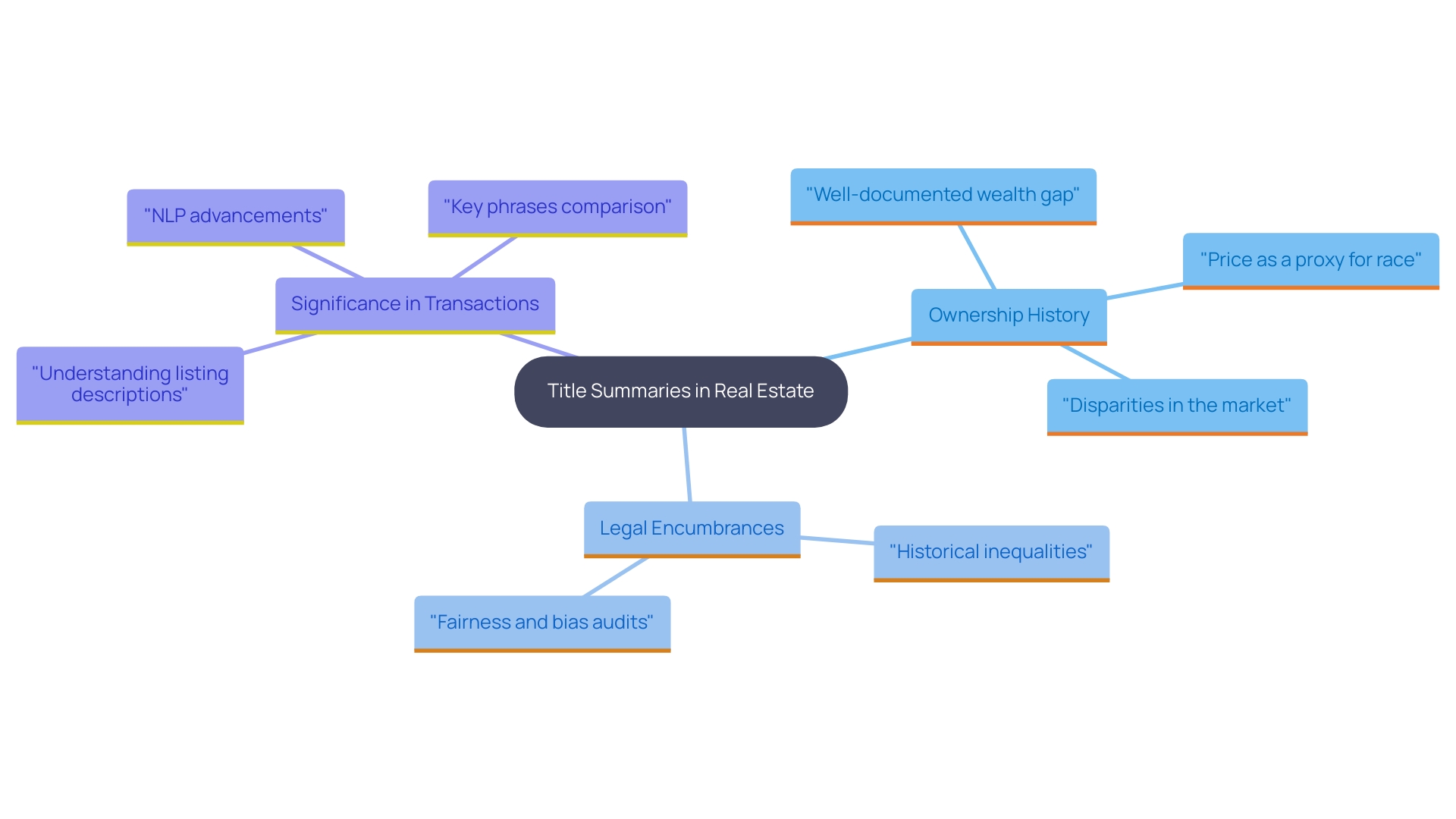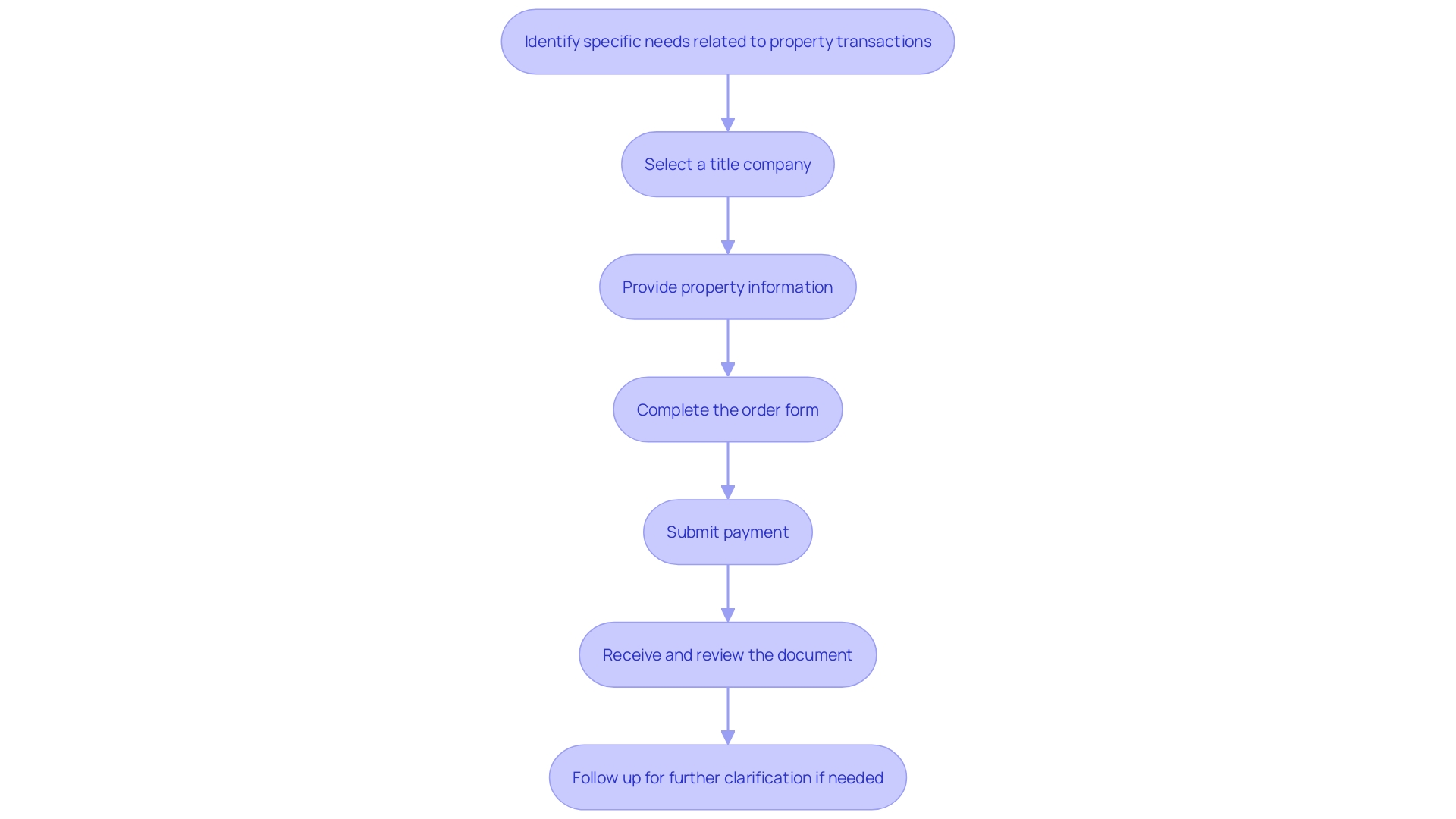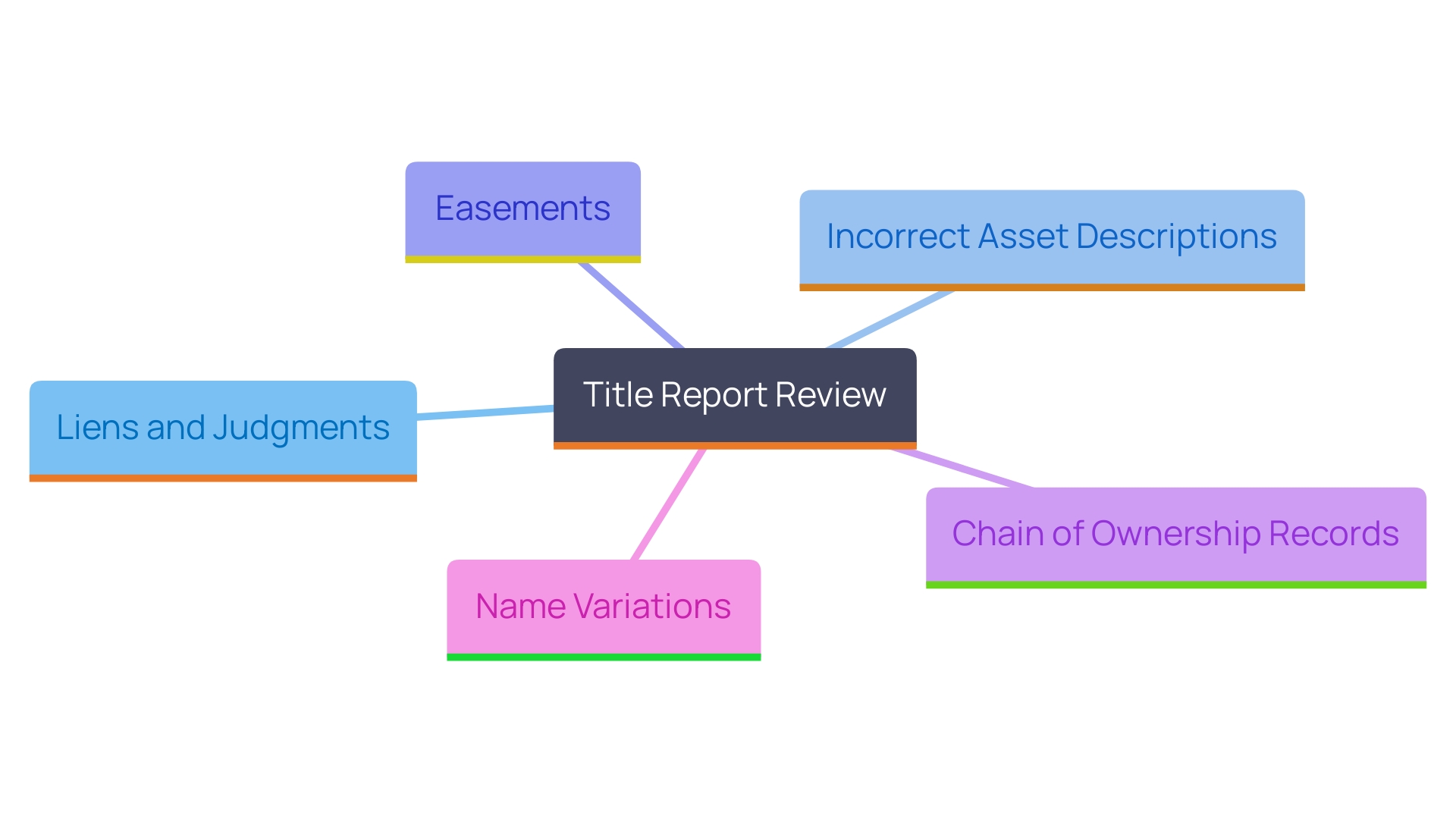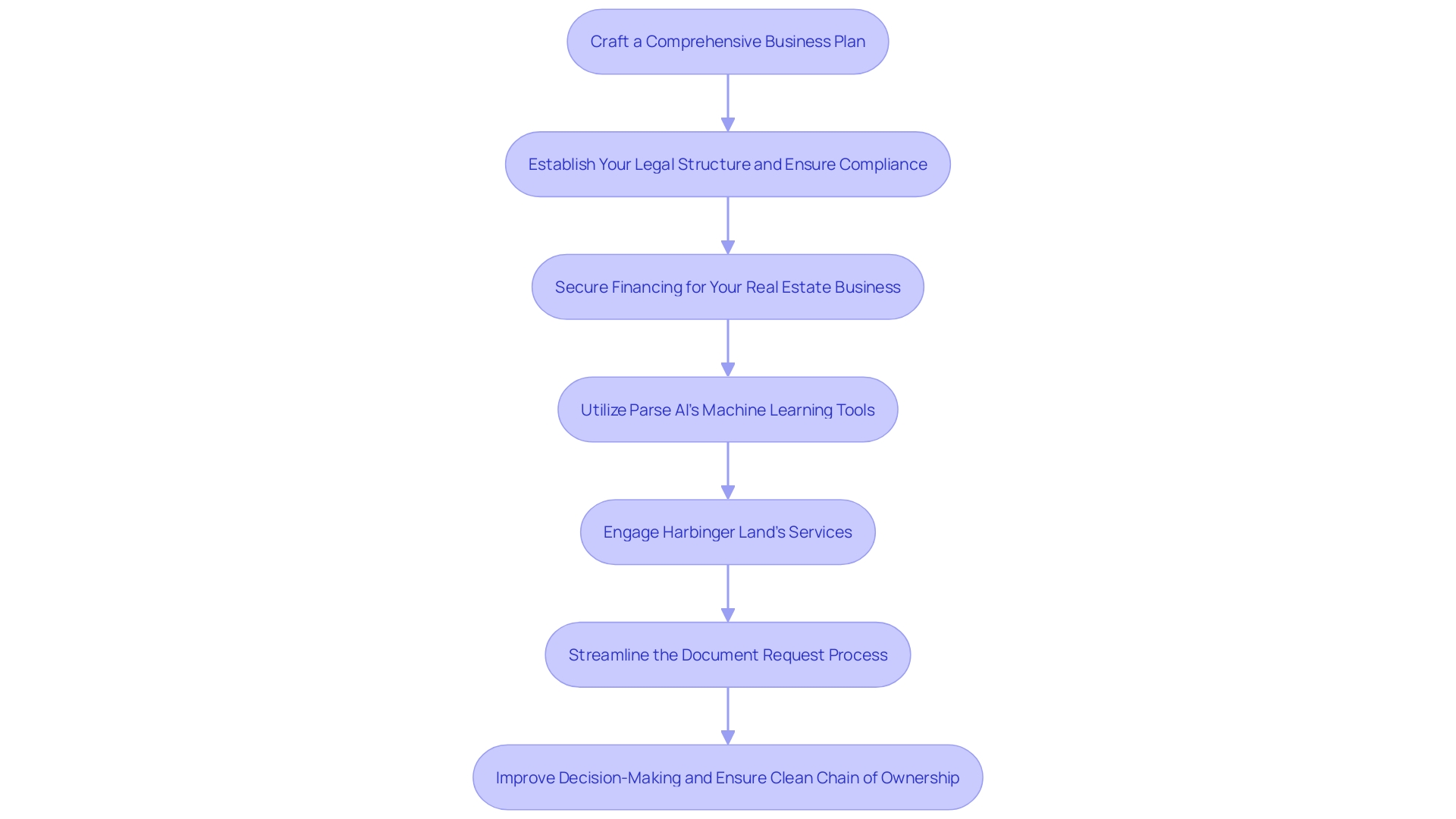Introduction
In the intricate world of real estate, understanding the nuances of title reports is paramount for anyone involved in property transactions. These comprehensive documents not only confirm ownership but also reveal critical details about liens, easements, and other encumbrances that could impact a property's legal standing. As buyers, sellers, and lenders navigate the complexities of real estate dealings, the importance of a meticulous title report cannot be overstated.
This article delves into the definition and significance of title reports, outlines the step-by-step process for ordering one, highlights common issues to watch for, and emphasizes the role of advanced technology in streamlining title research. By equipping professionals with this essential knowledge, the aim is to foster informed decision-making and facilitate smoother transactions in the ever-evolving property landscape.
Understanding Title Reports: Definition and Significance
A title summary is a thorough document that outlines the history of an asset, confirming its possession and detailing any liens, mortgages, easements, or other encumbrances that may affect the asset. It acts as a safeguard for buyers, lenders, and sellers, ensuring that the asset being transacted is free from legal issues.
Title documents are essential in real estate transactions as they aid in avoiding conflicts regarding ownership and offer a clear comprehension of the property’s legal status.
For experts in the real estate field, possessing a dependable document is crucial for making informed choices and enabling seamless transactions.

The Process of Ordering a Title Report: A Step-by-Step Guide
- Identify Your Needs: Determine the specific information you require from the title document. Are you purchasing a property, refinancing, or conducting due diligence? This will affect the kind of document you require.
- Choose a Title Company or Service: Research and select a reputable title company or online service that specializes in title documentation. Look for reviews and customer feedback to ensure reliability.
- Provide Property Information: Gather essential details about the property, such as the address, parcel number, and any prior ownership information. This data is crucial for producing an accurate document.
- Complete the Order Form: Fill out the order form on the company's website, ensuring all required fields are completed. Double-check your information for accuracy to avoid delays.
- Submit Payment: Pay the necessary charge for the document. Payment methods may vary, so choose the one that is most convenient for you.
- Receive and Review the Document: Once your order is processed, you will obtain the document via email or through the company’s portal. Review the document carefully, looking for any discrepancies or issues that may need further investigation.
- Follow Up as Needed: If you have on any aspect of the document, do not hesitate to reach out to the company for assistance. They can provide additional context and support to ensure you fully understand the findings.

Common Issues to Look For in Title Reports
When reviewing a title report, be on the lookout for the following common issues:
- Liens and Judgments: Ensure that there are no unpaid liens or judgments against the property, as these can affect ownership and must be resolved before closing.
- Incorrect Asset Descriptions: Verify that the asset description aligns with the actual boundaries and details. Discrepancies can lead to legal complications.
- Easements: Check for any easements that may grant others rights over the property, which could impact your intended use of the land.
- Chain of Ownership Records: Examine the chain of ownership records for any irregularities, such as missing transfers, which can suggest disputes regarding property rights.
- Name Variations: Be aware of variations in names or entities that could lead to confusion regarding ownership rights.

Conclusion and Next Steps
In conclusion, although requesting a document online can be straightforward, it requires several essential steps that can greatly influence the success of . By utilizing Parse Ai's advanced machine learning tools for document processing and research automation, you can enhance both the efficiency and accuracy of this process.
For instance, our tools can quickly analyze large volumes of unstructured documents, allowing for faster extraction of vital information, which ultimately leads to more informed decisions. Furthermore, grasping the importance of documentation, along with the thorough and accurate research offered by Harbinger Land, enables you to maneuver through the intricacies of real estate transactions with assurance.
Harbinger Land's curative services further ensure a clean chain of ownership, facilitating accurate leasing for property and mineral owners. As a next step, we encourage you to reach out to Parse AI or Harbinger Land to initiate your title report order and leverage our expertise to ensure a smooth transaction.

Conclusion
Understanding the intricacies of title reports is essential for anyone involved in real estate transactions. These comprehensive documents not only confirm ownership but also highlight potential issues such as liens, easements, and inaccuracies that could jeopardize a deal. Following a systematic approach when ordering a title report—identifying needs, selecting a reputable title company, and meticulously reviewing the report—can significantly reduce the risk of complications during the transaction process.
It is imperative to remain vigilant for common issues that can arise within title reports. By ensuring that no liens or judgments exist, verifying property descriptions, and understanding any easements, stakeholders can protect themselves from future disputes. Advanced technologies, such as those offered by Parse AI, can further streamline this process, allowing for quicker and more accurate title research.
Ultimately, a thorough understanding of title reports and the steps involved in procuring them equips real estate professionals with the tools necessary for informed decision-making. Embracing these practices ensures not only a smoother transaction experience but also fosters confidence in the legal standing of properties involved in real estate dealings. Engaging with experts like Parse AI and Harbinger Land can further enhance this process, ensuring that every property transaction is conducted with clarity and precision.
Discover how Parse AI can enhance your title research efficiency—get started today!
Frequently Asked Questions
What is a title document in real estate?
A title document is a comprehensive record that details the history of a real estate asset, verifying its title and outlining any liens, mortgages, easements, or other burdens that may affect the asset. It protects buyers, lenders, and sellers by ensuring that the asset is free from legal issues.
Why are title documents important in real estate transactions?
Title documents are crucial as they help avoid conflicts regarding ownership and provide a clear understanding of the property's legal status, enabling informed decisions and smooth transactions for real estate professionals.
What steps should I follow to obtain a title document?
The steps to obtain a title document include: 1. Identify your needs for the document. 2. Choose a reputable title company or service. 3. Provide essential property information. 4. Complete the order form accurately. 5. Submit payment for the document. 6. Obtain and examine the document for discrepancies. 7. Follow up with the company for any clarifications needed.
What common issues should I look for when reviewing a title report?
When reviewing a title report, check for: - Liens and judgments that could affect ownership. - Incorrect asset descriptions that may lead to legal complications. - Easements that grant others rights over the property. - Irregularities in the chain of ownership records. - Variations in names or entities that could confuse ownership rights.
How can advanced tools and services improve the process of obtaining title documents?
Advanced tools and services, such as those offered by Parse Ai and Harbinger Land, enhance the efficiency and accuracy of document processing and research, helping to mitigate common challenges like delays and inaccuracies in documentation.




